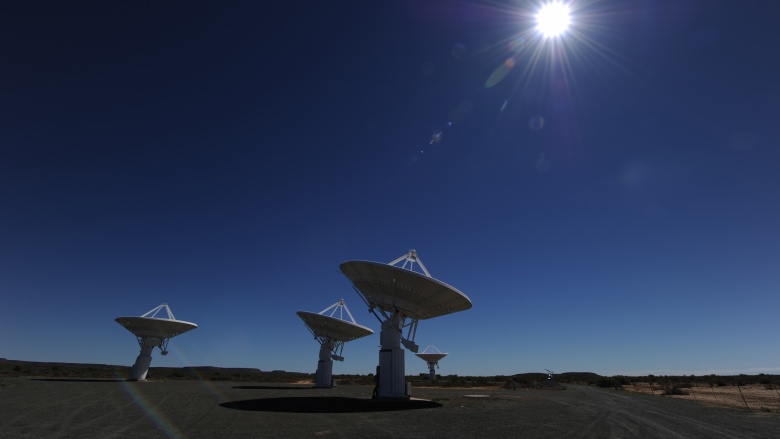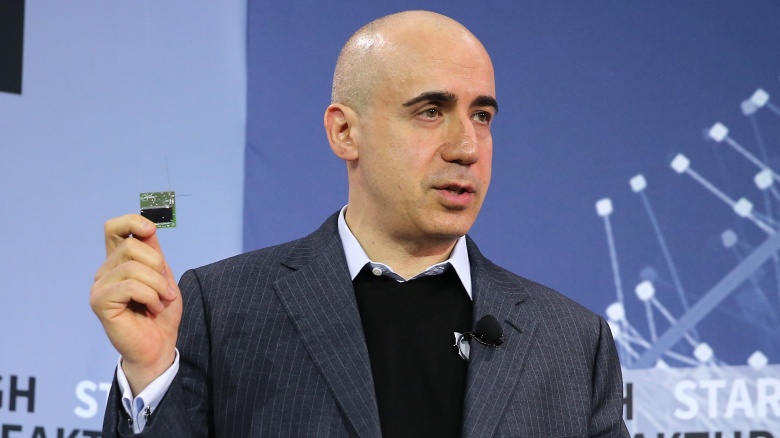Stephen Hawking's Interstellar Starchips Explained
Start filling out your Starfleet applications: super-brain Stephen Hawking and science-loving Russian billionaire Yuri Milner, founder of Breakthrough Initiatives, are building a rocketship to the stars through a joint venture called Breakthrough Starshot. Though it sounds like the plot to an obscure sci-fi movie, it's actually going to happen, as of this writing. And here's just what they intend to do with it.
No more just sitting around waiting for a return call, sorta
For decades now, scientists have contented themselves with sending radio signals into the endless, black void surrounding our planet, hoping to hear back from someone or something. While those transmissions travel farther and farther until the end of time, they have a limitation. There's no way of getting any kind of information back with them. For all we know, aliens have received them and are just letting the phone ring. Basically, humanity is left waiting for a hollaback that'll never come. Hawking and Milner's proposal, Breakthrough Starshot, will enable scientists to actually collect some data. Their massive fleet of tiny ships, if they work correctly, will collect information and fire it back to our tiny, blue ball. So even if there's alien life out there that has yet to develop technology to answer our calls, let alone intelligent life that has surpassed humanity's, scientists will know about it.
Better exploration through technology
Let's go into some more detail about those ships. A post on Gizmodo explains that Hawking and Milner plan to launch an armada of small spaceships into space, with the hopes that these ships will actually find something. But calling them "spaceships" is a bit of a misnomer. They're not ships in the traditional sense, as they won't be carrying any passengers. They won't be big enough for that. They're actually super-small computers, only about a gram in weight, what Milner calls "nanocrafts" or "Starchips," equipped with, "cameras, photon thrusters, power supply, navigation, and communication equipment." Essentially, that's all the tech needed to commit some serious intergalactic intrusions. And they're small enough to fit in your hand, like the prototype in Milner's hand pictured here. So, like the radio waves, they'll be able to keep going and going, but unlike the radio waves, Starchips will be able to collect data and transmit it back to earth. So even if ETs have been ignoring our calls all this time...well, they'll still be able to ignore them, but at least we'll know if they're home or not. And we'll know a lot sooner than in years past.
The speed of the craft
Because of the distances the Starchips will have to travel, they'll need to be fast. Otherwise, there's no point to this endeavor. Crafts too slow to make the journey in a sufficient length of time already exist. Breakthrough Starshot's first projected destination is our closest neighbor in the universe, Alpha Centauri, which is a little more than four light years away, or about 1.3 parsecs, which we all know is a unit of distance (right George Lucas?). With conventional space shuttles, it'd take more than 81,000 years, according to Universe Today. But Hawking and Milner's little ships won't be using the standard methods of galactic transportation. For the Starchips, science will be rolling out bright, shiny, new pieces of technology that'll whip them across that distance at about 100,000,000 miles per hour. That means they can cover the distance in about 20 years. This is good news for most of you reading this, because if it works, it means we'll have hard data from across the universe within your lifetime. If you're a senior citizen, you're probably out of luck. Sorry.
Speed bumps in the way
Of course, Hawking's and Milner's plans aren't going to be carried out tomorrow. Or even the day after. A few things need to happen in the next couple of years. For one, technology needs to catch up with the plans. There is a chance of this happening though, because of Moore's Law (via Vice). Coined by Gordon E. Moore, founder of Intel, his law observes that every two years, the number of transistors that can be crammed into a computer doubles. Because of this, Hawking and Milner will be able to build the miniscule, featherweight ships they're planning on shotgunning into space. They also planning on using solar sails to propel the Starchips. Only slightly heavier than the chips, solar sails work the same way as conventional sails do, only they harness light instead of wind. Doing this, according to their plan, will rocket the chips at the needed speed, 20 percent the speed of light.
They need to be able to literally get these chips off the ground too, so for propulsion, they plan on using lasers. According to Milner (via Gizmodo), the lasers will deliver about the same amount of force with which space shuttles are launched today, only they won't be using rocket fuel, just chemicals. And since the Starchips are much smaller than the shuttles, it'll be like the difference between throwing a bowling ball and throwing a pebble, only cooler and with frickin' lasers.
Lastly, the two science-bros still need to think of a way to transmit the collected data across the empty void of space. But if Matthew McConaughey can figure that out, surely Stephen Hawking has a chance of finding a solution.
They may have to share their new toys
Before the Starchips leave the solar system, they may have to make some stops along the way (and they haven't even left the planet yet). For years, astrobiologists have been wanting to study the possibility of life in our own solar system. Now, thanks to Breakthrough Initiatives, they may get this chance. According to Breakthrough Starshot co-sponsor and Harvard Center for Astrophysics chair Avi Loeb (via Gizmodo), the nanocrafts could easily fly to the other planets, planetoids, and dwarf planets in our solar system to collect data, such as the southern pole of Saturn's moon Enceladus, before continuing on to a more impressive destination. It makes sense that we should learn more about our own neighborhood before venturing out into farther parts unknown. Breakthrough says this tech can also be used to make better telescopes, as well as detect asteroids. However, it could be a ploy on Loeb's part to get more people on board, like the way kids, to get what they want, promise to share when they have no intention of doing so.
It doesn't mean mass evacuation of earth...yet
The tech necessary to make Hawking's and Milner's dreams comes true is a few years, if not decades, down the road. And the craft they're talking about is miniscule. The solar sails are projected to be about a meter—three-feet, three-inches—in size, and the nanocraft, no bigger than a postcard, if that. As such, they can't carry a person. Also, even at the initial, projected goals, the Starchips will take the aforementioned two decades to reach Alpha Centauri. Most people can barely handle twenty-four hour flights, let alone a two decade trip, so don't pack your bags just yet. It's going to take a special kind of person to cover that distance, and not just the rich kind. And no, sitting on your butt watching football every weekend is not adequate training.






